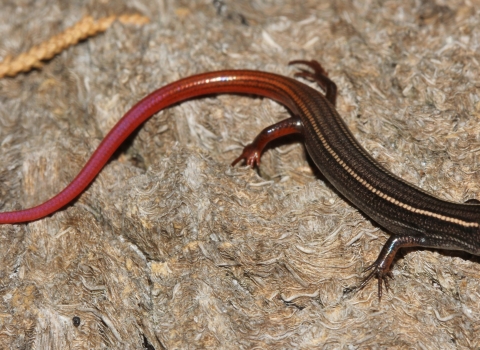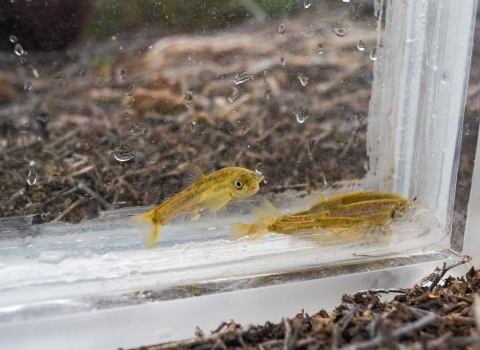RENO, Nev. — The U.S. Fish and Wildlife Service and Pyramid Lake Paiute Tribe today broke ground on a fish passage fish passage
Fish passage is the ability of fish or other aquatic species to move freely throughout their life to find food, reproduce, and complete their natural migration cycles. Millions of barriers to fish passage across the country are fragmenting habitat and leading to species declines. The U.S. Fish and Wildlife Service's National Fish Passage Program is working to reconnect watersheds to benefit both wildlife and people.
Learn more about fish passage project at Numana Dam supported by President Biden’s Investing in America agenda, a core pillar of Bidenomics, that will benefit the recovery of two federally listed species, the Lahontan cutthroat trout and Cui-ui sucker, in northern Nevada.
In 2022, the U.S. Fish and Wildlife Service awarded the Tribe nearly $8.3 million from the Bipartisan Infrastructure Law to support the Pyramid Lake Paiute Tribe’s vision of addressing a more than 100-year-old barrier to fish migration along the Truckee River at Numana Dam. Both fish are central to the Tribe’s culture and have been negatively impacted by water infrastructure and land use changes over the last century.
Deputy Director for the Service Siva Sundaresan today joined representatives from the Service, Bureau of Indian Affairs, Bureau of Reclamation and other partners today to celebrate this project and what it signifies for the recovery of the Cui-ui sucker and the Lahontan cutthroat trout.
“President Biden’s Investing in America agenda is making historic investments to restore our nations lands and waters, protect fish and wildlife and advance local communities and economies,” said Deputy Director Sundaresan. “We’re thrilled to break ground on this important project today which showcases the Department’s dedication to investing in conservation efforts that are inclusive, collaborative, locally led and honor Tribal sovereignty.”
“We are proud of our longstanding partnership with the Pyramid Lake Paiute Tribe and others to support recovery efforts for Cui-ui sucker and Lahontan cutthroat trout. Together, we have made significant progress over the last 50 years,” said Paul Souza, Pacific Southwest regional director for the U.S. Fish and Wildlife Service. “The investment of Bipartisan Infrastructure Law Bipartisan Infrastructure Law
The Bipartisan Infrastructure Law (BIL) is a once-in-a-generation investment in the nation’s infrastructure and economic competitiveness. We were directly appropriated $455 million over five years in BIL funds for programs related to the President’s America the Beautiful initiative.
Learn more about Bipartisan Infrastructure Law funds at Numana Dam will augment our past and existing recovery efforts for these iconic and culturally important fish by opening up more than 65 miles of historic habitat for the first time in over 100 years.”
“The Pyramid Lake Paiute Tribe is excited to implement another project to reverse centuries of obstacles to fish spawning in the lower Truckee River,” said Pyramid Lake Paiute Tribal Chairman James Phoenix. “This project will allow both the endangered Cui-ui and threatened Lahontan cutthroat trout, each of which is culturally and spiritually important to the members of the Pyramid Lake Paiute Tribe, to once again access their historic spawning areas on and upstream of the Tribe’s reservation. On behalf of the Tribe, I want to sincerely thank our federal partners for helping to make this much-needed project a reality.”
“The Numana Dam diversion structure structure
Something temporarily or permanently constructed, built, or placed; and constructed of natural or manufactured parts including, but not limited to, a building, shed, cabin, porch, bridge, walkway, stair steps, sign, landing, platform, dock, rack, fence, telecommunication device, antennae, fish cleaning table, satellite dish/mount, or well head.
Learn more about structure is an important facility for delivery of irrigation water used to fulfill the Tribe’s Federal decreed water rights,” said Jessie Durham, Western regional director for the Bureau of Indian Affairs. “The Bureau is pleased to be a partner in this collaborative effort to resolve a major fish passage issue for the Pyramid Lake fishery resources which are so important to the Tribe and its members.”
“Reclamation is pleased to support this exciting project to further benefit Lahontan cutthroat trout and Cui-ui,” said Bureau of Reclamation Regional Director Ernest Conant. “We are thrilled to see additional projects that build off the success of the recently completed Derby Dam fish screen, and of course, to continue our long-standing relationship with the Service and the Tribe.”
Installing a permanent roughened rock ramp at Numana Dam will open 65 miles of habitat along the Truckee River for the endangered Cui-ui sucker, and for the recently established migration of the threatened Lahontan cutthroat trout from Pyramid Lake. Access to this habitat is essential for the recovery of the species in the wild.
Numana Dam is an irrigation diversion structure within the boundary of the Pyramid Lake Paiute Tribe Reservation and provides irrigation water to the Pyramid Lake Paiute Tribal farmers and ranchers. This structure has been in place since 1917 and, in its present form, has been a significant passage barrier for the Cui-ui sucker and Lahontan cutthroat trout.
This project also supports Pyramid Lake’s fishery, a recreational, world-class fishery that is recognized locally, nationally and internationally, through recovery of this iconic population of Lahontan cutthroat trout.
Around the world, millions of barriers are fragmenting rivers, blocking fish migration, and putting communities at higher risk to flooding. Improving fish passage is one of the most effective ways to help conserve vulnerable species while building safer infrastructure for communities and improving climate resilience. Since 2021, the Service has announced 79 projects that will address outdated or obsolete dams, culverts, levees and other barriers fragmenting our nation’s rivers and streams that are part of a five-year, $200 million commitment through the historic Bipartisan Infrastructure Law, which provides a once-in-a generation opportunity to invest in climate resilient infrastructure, healthy rivers and streams, and abundant fisheries.
The National Fish Passage Program is a national leader connecting watersheds and people. The program has decades of experience implementing infrastructure projects with partners. Under the Bipartisan Infrastructure Law, we are bringing that experience to bear to foster collaboration between federal agencies, Tribes, states, and non-profit partners.
Since 1999, the program has worked with over 2,000 local communities, Tribes, and private landowners to remove or bypass over 3,400 barriers to fish passage and reopen access to over 61,000 miles of upstream habitat for fish and other animals. The Service and the National Fish Passage Program are committed to reconnecting rivers for the benefit of all.
Images related to this project can be found on Flickr: https://flic.kr/s/aHBqjASFaC
-FWS-
The U.S. Fish and Wildlife Service works with others to conserve, protect, and enhance fish, wildlife, plants, and their habitats for the continuing benefit of the American people. For more information about our work and the people who make it happen, visit our website or connect with us via Facebook, Twitter, YouTube, Instagram and Flickr.



